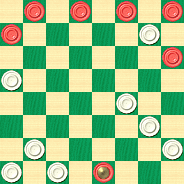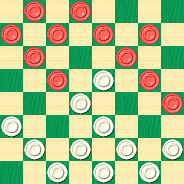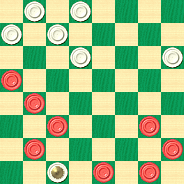The Checker Maven
Jump to navigationA Checker Author, Too

Fred Reinfeld is a member of the United States Chess Hall of Fame, and quite deservedly so. As a champion player and prolific writer and teacher, his gift for turning complexity into comprehensibility has brought chess lore and learning to millions of players over the years.
What is less well known is that Mr. Reinfeld, who passed away at only age 54, wrote on many other subjects; he was a checker author, and, alas, has gotten little recognition for his single work, How to Win at Checkers (which has appeared in various other forms and titles but is essentially the same item). That's a shame, as this book, still in print in an inexpensive softcover edition, provides much worthy material for beginning to lower-intermediate players (see our Book Reviews, linked in the right-hand column). If you don't have this book, you really ought to get it.
The book does, however, have a couple of rough spots (rather few, as it turns out), and today we're inviting you to work through them and gain a little of recognition for yourself (even if only you will ever know). Let's start with the easy one first, which arises from the Denny opening.
Situation One
| 10-14 | 24-19 |
| 11-16 | 28-24 |
| 16-20 | 19-15 |
| 9-13 | 23-19 |
| 7-10 | 32-28 |
| 14-18 | 21-17 |
Here White should have played 26-23, which maintains a very slight advantage. But now watch Black take advantage of White's error:
| 10-14 | 17-10 |
| 13-17 | 22-13 |
| 18-23 | 27-18 |
| 20-27 | 31-24 |
| 8-11 | 15-8 |
| 6-31 |
BLACK

WHITE
White to Play, Black Wins
W:W8,13,19,24,25,28,29,30:B1,2,3,4,5,12,K31.
Mr. Reinfeld concludes at this point, "Black wins. He will win the man on 8, and he has a King." While it turns out that Black indeed does win, it may not be as obvious as Mr. Reinfeld implies, at least to the eyes of a non-expert player. In fact, a beginner might attempt the following sequence:
| 24-20 | 4-11 |
| 30-26 |
which swaps off the king and maintains material equality, or so it seems.
Your task in this position is twofold: (a) show why trading off the king in this manner loses; and (b) from Diagram 1, demonstrate the Black win. Neither of these assignments are all that hard.
Situation Two
Here's another Denny opening:
| 10-14 | 22-18 |
| 11-16 | 25-22 |
| 16-20 | 24-19 |
| 8-11 | 19-15 |
| 4-8 | 22-17 |
| 12-16 | 17-10 |
| 7-14 | 29-25 |
| 3-7 |
BLACK

WHITE
White to Play and Win
W:W15,18,21,23,25,26,27,28,30,31,32:B1,2,5,6,7,8,9,11,14,16,20.
| ... | 15-10 |
| 6-29 | 30-25 |
| 29-22 | 26-3 |
| 8-12 | 3-8 |
WHITE

BLACK
Black to Play and Draw
B:W32,31,28,27,23,21,K3:B20,16,11,9,8,5,2,1.
and now Mr. Reinfeld tells us, "White wins. His King will prove too strong for the Black men."
But the problem with this is that White, despite the spectacular fireworks, is a man down! So we now come to a rather difficult threefold assignment: (a) show that the position in Diagram 2B is a draw; (b) show that, after 3-7 above, Diagram 2A, White actually does win, but not with 15-10; and (c) in the runup to Diagram 2A , find Black's losing move and correct it.
And if you really want some respect, show that 2-7 instead of 3-7 still loses (we haven't included the solution; you're on your own)[1].
We've probably outlined several days of work, but when you're ready, click on Read More for some potential solutions.![]()
Fred Reinfeld's photo is used with the kind permission of his son, cellist and bow maker Don Reinfeld.
[1] 12-1/2 years after publication we revisited this analysis with the latest KingsRow computer engine, and found the position is indeed a draw after 2-7! Congratulations Mr. Reinfeld, it's to you that our respect goes.
Solutions
You might wish to print out this page, as following the play can get more than a little complicated.
Situation One
First, White's attempt to trade off the Black king fails: 24-20 4-11 30-26 31-22 25-18 5-9 13-6 1-10 29-25 3-7 25-22 Black Wins; White must either pitch a man or submit to a two-for-one.
But Black wins in any event. Here is one possible continuation: 25-22 4-11 22-18 11-16 19-15 31-26 30-23 5-9 13-6 1-26 and it's all over. You can work out responses to other White initial moves for yourself ( 25-21 is about as good, or bad, as 25-22, and loses in a manner similar to an attempt to trade off the Black king).
Situation Two
This one is quite a bit harder, and we've relied on the KingsRow computer program for our analysis. Starting from Diagram 2B, we find the following neat draw:
| 8-12 | 3-8 |
| 11-15 | 8-11 |
| 15-19 | 23-18 |
| 9-14 | 18-9 |
| 5-14 | 27-24 |
| 20-27 | 31-15 |
| 16-19 | 11-16 |
| 19-23 | 16-19 |
| 23-26 | Drawn. |
KingsRow evaluates this position at -6, a very slight advantage to White but still drawn (and Ed Gilbert verified this as a draw with his 10-piece endgame database).
Demonstrating the win after 3-7 is not easy. Here is the KingsRow analysis, starting at Diagram 2A; other variations are possible.
| ... | 28-24 |
| 16-19 | 23-16 |
| 14-23 | 26-19 |
| 11-18 | 31-26 |
| 6-10 | 16-12 |
| 18-22 | 26-17 |
| 9-13 | 12-3 |
| 13-29 | 21-17 |
| 10-14 | 3-10 |
| 14-21 | 10-14 |
| 29-25 | 14-17 |
| 5-9 | 19-15 |
| 1-5 | 24-19 |
| 9-13 | 17-14 |
| 2-6 | 14-18 |
| 6-9 | 18-23 |
| 25-22 | 19-16 |
and White should now win without much trouble (you can use your computer to show it).
What was Black's losing move in the runup? 12-16, whereas 9-13 would have lead to a theoretical draw.
Demonstrating a probable White win after 2-7 (instead of 3-7) is more than we can fit in an article that is already long and complex. KingsRow scores this move as -62, which is a likely White win; again, you might wish to spend some time with your computer to work this out[2].
[2] As we noted above, it's a draw after 2-7, and our October 2018 KingsRow analysis is shown below. You can't help but admire Black's pitch at move 17, securing the draw.
| 1. | ... | 25-22 |
| 2. | 7-10 | 23-19 |
| 3. | 16x23 | 26x19 |
| 4. | 14x23 | 27x18 |
| 5. | 10-14 | 31-27 |
| 6. | 14x23 | 27x18 |
| 7. | 9-13 | 21-17 |
| 8. | 3-7 | 19-16 |
| 9. | 20-24 | 28x19 |
| 10. | 11x20 | 19-16 |
| 11. | 7-10 | 16-12 |
| 12. | 10x19 | 12x3 |
| 13. | 19-23 | 18-15 |
| 14. | 20-24 | 15-11 |
| 15. | 24-27 | 17-14 |
| 16. | 27-31 | 22-18 |
| 17. | 23-26 | 30x23 |
| 18. | 31-26 | 23-19 |
| 19. | 26-23 | 19-15 |
| 20. | 23-19 | 14-10 |
| 21. | 13-17 | 3-8 |
| 22. | 17-21 | 11-7 |
| 23. | 21-25 | 8-12 |
| 24. | 6-9 | 7-3 |
| 25. | 19-23 | 12-16 |
| 26. | 23x7 | 3x10 |
| 27. | 25-30 | 10-7 |
| 28. | 30-26 | 7-3 |
| 29. | 1-6 | 15-11 |
| 30. | 9-14 |
etc., to a draw.
You can email the Webmaster with comments on this article.
